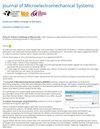Nonlinearity Reduction in Three-End Serpentine Torsion Bar of MEMS Mirror
IF 3.1
3区 工程技术
Q2 ENGINEERING, ELECTRICAL & ELECTRONIC
引用次数: 0
Abstract
Serpentine springs are widely employed in microelectromechanical systems (MEMS) accelerometers, resonators, and mirrors due to their unique advantages, including a wide adjustable stiffness range and minimal area occupation. Despite these advantages, the inherent nonlinearity of the serpentine torsion bars, whose origin remains unclear, imposes limitations on the performance of MEMS mirrors. This study investigates the nonlinearity of the three-end serpentine torsion bars, which consist of middle and side beams. Through the derivation of spring constants for both the middle and side beams and the definition of a nonlinear factor for the serpentine torsion bars, it was established that the nonlinearity is predominantly influenced by the center offset of the side beam. A specific three-end serpentine torsion bar was utilized to examine the effects of the center offset of the side beam. The variation in the cubic spring constant of the serpentine torsion bars (MEMS反射镜三端蛇形扭杆的非线性减小
蛇形弹簧由于其独特的优点,包括宽的可调刚度范围和最小的面积占用,被广泛应用于微机电系统(MEMS)加速度计、谐振器和反射镜中。尽管有这些优点,蛇形扭转杆固有的非线性(其起源尚不清楚)限制了MEMS反射镜的性能。研究了由中梁和侧梁组成的三端蛇形扭转杆的非线性特性。通过推导中、侧梁的弹簧常数,定义蛇形扭转杆的非线性因子,确定了非线性主要受侧梁中心偏移量的影响。采用特定的三端蛇形扭转杆,考察了侧梁中心偏移量的影响。在中心偏移量调整过程中,蛇形扭转杆(${k} _{\mathbf{3}}$)的三次弹簧常数变化与侧梁(${k} _{\mathbf {s3}}$)的三次弹簧常数变化非常相似,在中心偏移量较小的地方出现了较弱的非线性。为了验证非线性降低的有效性,设计了一种带有弱非线性的三端蛇形扭杆的电磁MEMS反射镜。实验结果表明,该MEMS反射镜可以在3002.36 Hz的频率下线性工作,光学角度为95°。这一进展有望提高MEMS反射镜的性能并扩大其应用范围。[2025-0073]
本文章由计算机程序翻译,如有差异,请以英文原文为准。
求助全文
约1分钟内获得全文
求助全文
来源期刊

Journal of Microelectromechanical Systems
工程技术-工程:电子与电气
CiteScore
6.20
自引率
7.40%
发文量
115
审稿时长
7.5 months
期刊介绍:
The topics of interest include, but are not limited to: devices ranging in size from microns to millimeters, IC-compatible fabrication techniques, other fabrication techniques, measurement of micro phenomena, theoretical results, new materials and designs, micro actuators, micro robots, micro batteries, bearings, wear, reliability, electrical interconnections, micro telemanipulation, and standards appropriate to MEMS. Application examples and application oriented devices in fluidics, optics, bio-medical engineering, etc., are also of central interest.
 求助内容:
求助内容: 应助结果提醒方式:
应助结果提醒方式:


